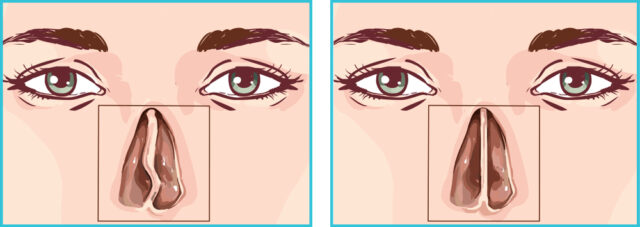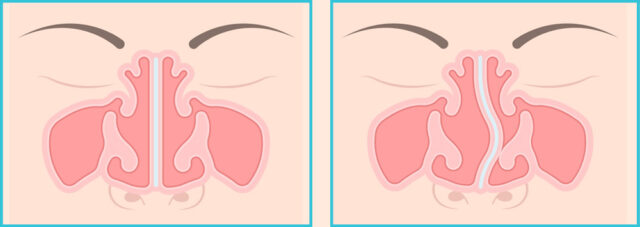Septum deviation is the crookedness of the nasal bone as called colloquially. Deviated septum causes numerous issues therefore it affects the life quality of people. We will talk about septum deviation in our blog post today and will try to answer all of your questions.
What deviates Septum?
A nose is the starting point of the respiratory tract and ensures healthy breathing, which is one of the most vital functions of the body system.
The nose is a tunnel divided in the middle by a wall. The nasal septum is the part that divides the nasal cavity into two parts. The medical name of this wall is “septum nasale”. The area we call the septum in the nose is a structure consisting of cartilage and bone, located in the middle of the nostrils that divides the nose into two air passages and extends to the nasal cavity. In the nose with deviation, this structure is not where it should be. Its midline may be more or less tilted to the side. It is considered to be healthy when the inner width, length, and volume of each tunnel are close to each other. In an ideal and healthy nose structure, two separate air passages are in a structure that expands towards the back. This expanding section ensures that the incoming air is warmed, humidified, and sent to the olfactory area. In addition, particles, which entered with air and larger than 5 microns are retained and filtered by the mucoid secretions on the nasal mucosa. Thus, the air transferred to the lungs is of a certain quality and clean. The health of our respiratory tract and lungs is related to the quality of the air taken. An individual with septum deviation does not have this nose structure. He has a curvature on his nose. The curvature of the nose, which causes problems while inhaling and exhaling, basically prevents airflow.
What are The Reasons Causing Septal Deviation?
The deviation may occur due to hereditary features or due to asymmetrical face shapes. In addition, deviations may occur as a result of blows to the nose from the outside in the later stages of life, which can usually be in childhood or adolescence. Nose development is a known process that continues until the age of 18. Blows to the nose during childhood can cause shifts of 1 millimeter. If these shifts are not taken into account, the shifts continue to grow as the nose structure develops.
In 80% of people, the septum is not located in the middle. This does not cause excessive discomfort. The fact that the septum is located much further from the middle side causes various health problems. The disease is defined as pronounced crookedness of the septum partially or completely, being shifted from the midline and affecting respiration. The air passage is often reduced on the curved side. The curvature is sometimes S or C-shaped and can block both sides of the nose. The greater the deviation, the greater the nasal congestion. When one side is obstructed, patients usually do not feel discomfort in this way, as they can breathe from the other side.
What Problems Cause Deviation?
Since deviation affects vital conditions such as breathing, it can cause many problems. We can list the problems caused by nasal cartilage curvature as follows;
- With nasal congestion, the person breathes through the mouth. Therefore, the air is not heated and humidified as in the nose, and the quality of the air going to the lungs decreases. This causes problems in the lungs and respiratory tract.
- Due to poor quality air, organs such as the throat, larynx, and lungs strive to improve the quality of the air. This can cause reactions.
- A snoring problem occurs.
- As the quality of breathing decreases, the quality of sleep also decreases, and its regularity is disrupted.
- Many situations such as headache and feelings of weakness during the day may be encountered.
- Excessive weight gain may occur.
- Diabetes may occur.
- Heart problems may occur.
The person who cannot breathe through the nose will have to breathe through the mouth. Mouth breathing has some downsides. We can list these negative aspects for you as follows;
- Dryness in the mouth.
- Breath odor.
- Problems with teeth and gums.
- Being off feed.
- Sneezing attacks.
- Weakness in sense of smell.
What are The Symptoms of Septum Deviation?
The deviation is a problem that can be seen from the outside of the nose. This is how the nasal bone curvature manifests itself. However, in some cases, some symptoms occur in the nose as well. We can list these symptoms as follows;
- Bilateral or unilateral nasal congestion.
- Mouth breathing.
- Sleeping with an open mouth.
- Sleep apnea and snoring.
- Persistent recurrence of sinus infection.
- Pain in the nose and middle of the face.
The operations performed to correct the curvatures of the septum, which separates the two nasal passages from each other and consists of cartilage in the front and bone in the back, are called “septoplasty”. Since septum deviation is a very common problem in society, “deviation surgeries” to correct this problem are among the most frequently performed surgeries.
The most common complaints in individuals with nasal cartilage curvature are snoring and nasal concha.
Septoplasty for Snoring Treatment
Septal deviation refers to the formation of curvatures in the nose, and septoplasty is the surgery applied to the operations performed to eliminate these curves. With septoplasty surgery performed under general anesthesia, you can get rid of symptoms such as snoring, frequent sinusitis infections, constant post-nasal drip, and chronic headache by correcting the curvature.
Septoplasty in The Treatment of Sleep Apnea
Sleep apnea is when you suddenly have respiratory failure for 10 seconds during sleep. During these 10 seconds, the airflow decreases by 50%, and the oxygen level in the blood decreases (desaturation), or awakening occurs. Sleep apnea, which reduces the quality of life at a high level, is seen between 5% and 10% in our country. You can say goodbye to sleep apnea problems and increase your quality of life with septoplasty, the treatment of septum deviation, which is one of the causes of sleep apnea.
Septoplasty for Sinusitis Treatment
There are cavities called sinuses around the nose. Sinusitis is the filling of these spaces with inflammation. Sinusitis causes a headache, shortness of breath, nasal congestion, and many other problems. If the deviation is detected in the patient’s nose together with sinusitis, sinusitis treatment can be performed with septoplasty. If the curvature is detected in the nasal structure, sinusitis causes a much greater breathing problem.
Those who want to get rid of sinusitis or want to get more information can read our blog post about Which method should be applied in sinusitis surgery?
Septoplasty in the Treatment of Concha Hypertrophy
There is no space like a tube inside the nose, and there are three pieces of meat called concha on each side. The task of these 3 turbinates, which are the lower, middle, and upper turbinates, is to warm, humidify and filter the inhaled air. Concha enlargement and swelling occur with the curvatures that occur with the deviation of the septum. Nasal congestion becomes more pronounced with hypertrophy. Hypertrophy refers to the overdevelopment of a tissue or organ. Concha hypertrophy is treated with medication or surgical methods. In some cases, a septoplasty operation can be performed in combination with a nose aesthetic operation called “rhinoplasty”. Concha hypertrophy, in which intranasal soft tissues swell due to allergies, etc., can also be treated by intervening in the same operation.
You can read our blog post called What is a nasal polyp? How is the treatment done? To get detailed information about nasal polyp treatment
How to decide on Septum Deviation Surgery (Septoplasty)?
The nose, which is a structure consisting of bone, cartilage, and tissues, is a whole that should not be separated into internal and external. Before the deviation surgery, the nose should be examined internally and externally and the problems should be determined. It should be determined whether there is a deviation sign outside the nose. If there is such a problem with the nose, the process should work together.
Nasal bone crookedness is a problem that is usually evident from the outside of the nose. Performing only intranasal deviation surgery causes the destruction of the patient’s nasal cartilages, and then extra nasal deviation surgery becomes very difficult.
The patient should also be consulted on this matter. If the patient requires an external intervention for the nasal bone crookedness, both the inside and outside of the nose should be operated on.
Septum Deviation Treatment Summary
| IMPORTANT: The information below has been prepared on general points related to the operation process. Everyone is unique. The treatment process, planning, and results of everyone who has had nose surgery may differ. |
| Operation Name |
Septorhinoplasty (Deviated nose treatment) |
Rest Time | 7 – 10 days |
| Used technique | Open and Closed aesthetic surgery technique | Amount of nights at the hospital | 1 night |
| Duration of the operation | 3 – 4 hours | Downtime Return to Work or Social Life | 10 – 14 days |
| Anesthesia type | General anesthesia | Final outcome | 2 – 12 months |
| Sensitive period | 5-7 days | Operation cost | Please get in touch for detailed information |
We have come to the end of our blog post about deviation prepared by TAS Aesthetic Surgery Center. Throughout the article, we answered your questions such as, “What is the deviation? “What are the signs of deviation?” and “How is septum deviation surgery done?”: If you want to get information about septum deviation surgery (Septorhinoplasty), you can read our blog post via the relevant link, or if you have other points that you want to learn about septum deviation, you can contact us by calling +90 543 456 36 93.


0 comments on “Deviated Septum (Crookedness of The Nasal Bone)”